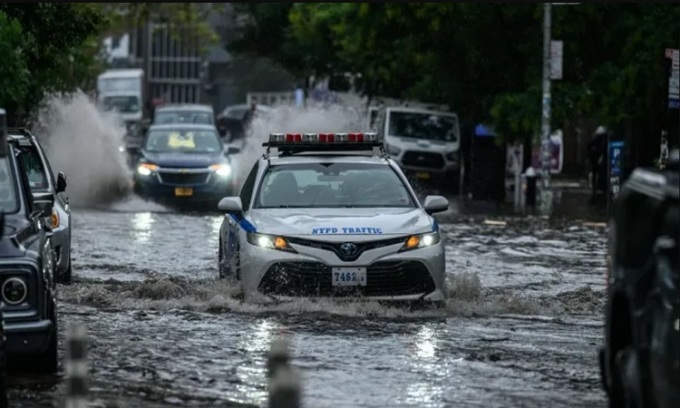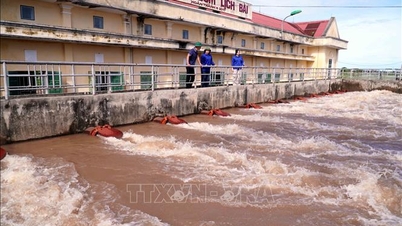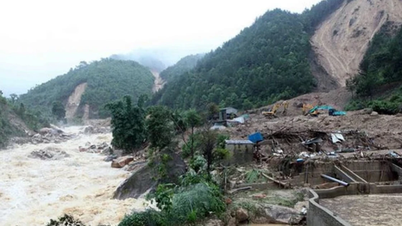Climate scientists say warmer temperatures cause the atmosphere to hold more moisture, which it pours down as heavy rains.

Heavy rain flooded New York streets on September 29. Photo: AFP
Torrential rains turned streets into rivers in Libya, Greece, Spain, Hong Kong, and parts of New York City in September 2023. Thousands died in Derna, Libya. Zagora, Greece, experienced a record 76.2 cm of rain, equivalent to 1.5 years' worth of rainfall, in 24 hours. A few weeks earlier, monsoon rains caused landslides and dangerous floods in the Himalayas, killing dozens of people in India, according to The Conversation .
After severe flooding on nearly every continent this year, including mudslides and floods in California in early 2023 and floods that devastated Vermont in July, it seems that extreme rainfall is becoming more common. Is global warming contributing to this trend, and importantly, what can we do to adapt to the new reality?
As a climate scientist, Mohammed Ombadi, an assistant professor at the University of Michigan, is exploring the link between climate change and extreme weather events and their impact on everyday life. Understanding the connection is important to developing appropriate adaptation measures to climate change.
Wetter atmosphere, more intense rain
As temperatures rise, the warmer atmosphere can hold more water vapor. More water evaporates from the land and oceans. That water eventually returns to the land and oceans. As the atmosphere absorbs more moisture, more rain falls in storms. Scientists predict that for every degree Celsius of warming, the intensity of heavy rain in storms will increase by 7%.
The phenomenon of increasing the amount of moisture the air can hold is called the Clausius-Clapeyron relationship. But other factors, such as changes in wind patterns, storm tracks, and air saturation, also contribute to rainfall intensity.
Rain and snow: rain plays the most important role
One factor that determines the severity of a flood is whether the water falls as rain or snow. Rainwater runs off almost immediately, while water released from melting snow melts more slowly, leading to more severe flooding, landslides and other hazards, especially in mountainous and downstream regions where a quarter of the world's population lives.
A higher ratio of heavy rain to snowfall is thought to be a key factor contributing to the Himalayan floods and landslides in August 2023, although scientists are still conducting research to confirm this. Additionally, an examination of flood models in 2019 across 410 river basins on the US west coast found that peak flows from rainfall were 2.5 times greater than those from snowmelt.
In a 2023 study in the journal Nature, Ombadi and colleagues showed that the intensity of heavy rainfall increased at a faster rate than would be expected from the Clausius-Clapeyron relationship, by as much as 15% for every degree Celsius of warming in high mountain regions like the Himalayas, Alps, and Rockies. The reason behind this amplification is that rising temperatures cause moisture to move to areas with more rain and less snow in those regions. A large portion of that water falls as rain.
In the study, Ombadi’s team looked at the heaviest rainfall events in the Northern Hemisphere since the 1950s and found that the intensity of heavy rainfall has increasingly changed with altitude. The mountainous western United States, parts of the Appalachian Mountains, the European Alps, and the Himalayas and Hindu Kush in Asia have also been hit hard. In addition, weather models show that most of these regions are likely to see a seven- to eight-fold increase in the likelihood of heavy rainfall by the end of the 21st century.
Floods are not just a short-term problem
Loss of life and property in cities gets the most attention after floods, but increased flooding also has long-term impacts on water supplies in reservoirs, which are vital to communities and agriculture in many regions. In the western United States, for example, reservoirs are often kept as close to their maximum levels as possible during the spring snowmelt to provide water during the dry summer months. Mountains act as natural reservoirs, storing snowfall in winter and slowly releasing the melted snow.
However, recent findings by Ombadi and colleagues suggest that the world is rapidly moving toward a climate dominated by heavy downpours, not snow. Water managers will need to leave more room in reservoirs to store large volumes of water in case of disasters, minimizing the risk of flooding downstream.
Prepare for a harsher future
Global efforts to reduce greenhouse gas emissions are increasing, but people still need to prepare for a more severe climate. The storms that devastated the Mediterranean in 2023 provide compelling evidence of the importance of adaptation. They broke rainfall records in many countries and caused widespread damage.
A major contributing factor to the disaster in Libya was the failure of old dams. This highlights the importance of updating design codes so that infrastructure and buildings can withstand future heavy rains and flooding, and investing in new engineering solutions that can increase resilience and protect communities from extreme weather.
An Khang (According to Conversation )
Source link



































































































Comment (0)